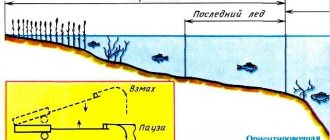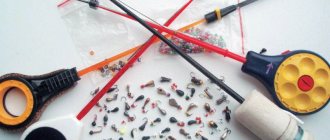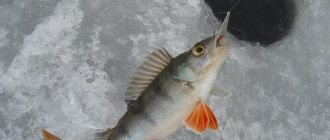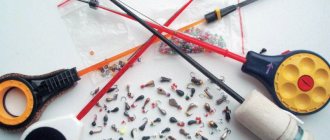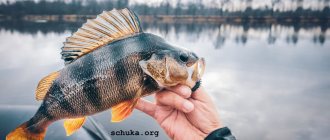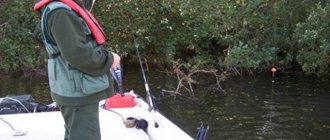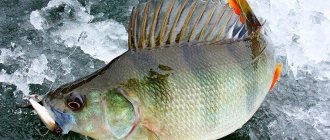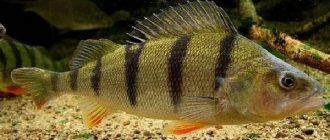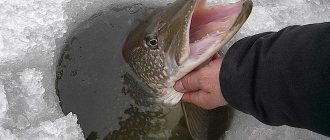What is a winter amphipod bait and how does it work?
To ensure that catching perch with amphipods in winter is guaranteed to be successful, exciting and productive, you need to know what kind of bait it is and the principle of its operation. Amphipod is an effective lure for predators, working where others are powerless. Its name has no overlap with the freshwater crustacean; it reflects the peculiarity of its behavior in water - when gliding down, it rolls from one side to the other.
The horizontal metal spoon amphipod has a lot of advantages, including the uniqueness of the game. It varies depending on the wiring used. This makes it possible to work over large areas using only one bait. The only drawback noted is the lack of a lower tee, but this point can be corrected independently.
Fishing for amphipods from ice is characterized by the same yield of both capricious and active fish. The spoon makes circular movements at the moment of swinging the tackle, imitating the movements of the fry. When using amphipods for perch in winter, preference should be given to silver or copper models, selected according to weather conditions. Work in the horizontal plane of the bait is ensured by a shifted center of gravity and a special design. The spoon is equipped with stationary and removable tees for efficient search of predators.
A catchable amphipod functions like a balance beam, playing in a horizontal plane if there is a vertical suspension. The bait has a flat body and different thicknesses on the sides. This feature of the spoon allows it to periodically fall to one side when reeling.
In the center of the amphipod there is a through opening for the passage of fishing line with a tee. To stabilize the position, instead of the tail part, the bait has a tee hidden under a tuft of wool. Unlike a balancer, the spoon does not have hooks in the front part. The action of the bait is distinguished by its inherent smoothness and uniformity, very similar to the behavior of a flat balancer.
Strong oscillatory vibrations when rising upward are attractive to aggressive perch.
Wiring options
Of course, successful fishing for pike perch using amphipods in winter largely depends on the experience and skill of the fisherman himself. More precisely, depending on how he presents his treat, his chances of returning with a catch increase or decrease. Let's name the main fishing methods that allow you to fish in a variety of conditions.
Standard
This wiring allows you to maximize the capabilities of the bait in order to whet the appetite of the pike perch. Its essence is to periodically lift an artificial fish by 20-30 cm (two or three times per series) and then release it to the bottom. The last stage occurs in an arc and repeats the natural movements of the fry in the reservoir. Let us note that the fisherman makes the game effective (in terms of catch) only by 30%, and the amphipod itself - by 70%.
Figure-of-eight wiring
The essence of the method is to lower the pike perch to a level of 15-20 cm to the bottom. Then - a uniform rise of 50-60 cm with the release of the latter into “free swimming”. The cycle is repeated 7-8 times, after which a period of waiting for a bite begins. If the pike perch is nearby, it should respond to the offer. If this does not happen, it makes sense to change the hole and return here after a while.
Looking for luck through improvisation
In addition to the classic methods of guiding amphipods, there are several lesser known ones, such as:
- Balanced. With this wiring, an alternation of a toss of 10-15 cm and a pause is carried out. The optimal time interval is calculated experimentally.
- Mormuscular. Intense rocking and rotation create the complete illusion of the fry's natural movement.
- Asynchronous. We smoothly lead up to 30-40 cm, alternating with stepwise immersion 2-3 times.
The game of an amphipod under water largely depends on the location of the hole in its body. Thus, if it is shifted towards the head, it will “make” the bait “dance” in a completely different way than when positioned closer to the tail.
Professional fishermen change the trim solely by redistributing the weight along the length (this is important when using a homemade snag).
We recommend reading: How to catch an asp using a bombard
These suggestions for posting options can be easily supplemented or changed by each of you. You just have to show a little imagination.
How to choose in a fishing store
To make it easier to choose a working amphipod for winter perch fishing, take into account the selectivity of this predator in food during the cold season. When choosing an amphipod, focus not only on weather conditions, but also on the mood of the predator in a particular body of water.
If the weather is sunny, then baits with copper or brass colors will be catchy. Fishing for perch on cloudy days will bring success when using silver amphipods.
If there is a targeted hunt for large individuals, then it is worth choosing bait from 10 cm in length. For catching medium-sized perch, versions from 5 cm are suitable. A guaranteed catch will be obtained by selecting bait that is as similar in appearance to perch prey as possible.
Making amphipods for perch with your own hands
When making amphipods with your own hands, you can not only save money, but also get bait, as they say, “for yourself.” You can make an effective lure for perch, either according to your own considerations, or on the basis of already finished products. It can be cast into a mold or use a method of joining two metal plates by filling the space with solder.
Materials
Amphipods for perch can be made in two ways using different materials:
- A small fragment of foam rubber or polystyrene, a sharp hook and a lead pellet with a diameter of 4 mm, preferably dark in color.
- A piece of foam plastic, a hook, lead, a piece of wood, paint. Necessary equipment: scissors, brush, ruler, stationery knife, tape.
Making bait
To make amphipod for winter perch according to the first option, you must adhere to the following algorithm of actions:
- Process the future workpiece. The optimal thickness of the bait is no more than 2–3 mm.
- Place the workpiece on a hook size 1...5.
- Pull the thread.
- Trim off excess line.
- The perch bait is ready for use.
If the second manufacturing method is chosen, then the technology is as follows:
- Make a drawing and sample of an amphipod from a piece of polystyrene foam.
- Wrap the prepared block of wood with tape.
- Prepare a mixture of alabaster.
- Pour the composition into the mold.
- Spread the workpiece with a soap solution.
- Once dry, place into mold. But at the same time, the alabaster cannot be allowed to dry out completely.
- Use a sharp knife to make two holes in the spoon.
- Pour in alabaster, having previously treated it with a soap solution.
- Make two openings for mounting hooks.
- Improve the appearance by cutting through the scales after the bait has completely dried. This will make her much more attractive to a predator.
- Paint the spoon in different colors, preferably green. So, where there is no hook, it is recommended to use bright colors for successful fishing at serious depths.
- Make a hole, using a ruler to determine the center of gravity.
- Create an attractive ponytail. You can use different wool.
- If desired, add a tee to eliminate cases of bait loss in hard-to-reach places.
How to make amphipod with your own hands
The use of handmade baits will help you increase the percentage of bites, and at the same time the level of your skill.
By and large, super abilities are not needed here, but diligence, accuracy and love for your work will definitely be needed. For this you need:
- Preparation of the future shape (it is better to choose as a material: brass, copper, stainless or galvanized steel);
- Filling molds with lead;
- Soldering the hook into the tail part;
- Drilling a hole for attaching the bait;
- Artistic surface treatment (polishing, painting, varnishing);
- Production and design of the “tail”.
It is most convenient to decorate the tail part with fabric, natural or synthetic threads even before soldering it. It makes sense to equip the tail hook, like the one that will be on the fishing line, with colored beads. It is better to equip the central hole with a cambric. This will protect the line from abrasion.
Catching pike perch in winter using amphipod bait is not only an active recreation. Thanks to the capabilities of this device, you will have no reason to return from fishing without a catch. Well, take the fact that in addition to pike perch there will suddenly be pike or perch in it - take it as a bonus for your choice of this particular bait.
Tackle and rigging
For catching perch in winter, fishing rods that work with standard spoons and balancers are suitable. To collect balanced and reliable gear you will need:
- fishing rod (length 20–40 cm);
- plastic inertial coil;
- monofilament working line (thickness 0.15-0.20 mm);
- leash made of monofilament or fluorocarbon (breaking load is 15–25% greater than the main line).
Among winter fishermen, there is an opinion that it is worth equipping the tackle for perch with a nod. Its advantage is its ability to record even the most accurate bites of a predator, including sluggish ones. When using it, the action of the bait turns out to be quite smooth. But there is one nuance here - the complexity of the entire equipment. The fisherman decides whether to use a nod or not.
How to tie amphipods correctly
Even a beginner can tie an amphipod if he knows the main points of this process.
Installation steps:
- Pass the thread through the hole in the body of the bait. This must be done in such a way that its convex side faces the gear.
- Install a bead or silicone damper. Thanks to this limiter, it will be possible to protect the assembly from damage by the spinner.
- Fix the tee to the fishing line.
By mounting an amphipod on a perch using this technology, the angler provides him with sufficient freedom to perform an attractive game. The presence of a damper is not entirely necessary when using a thick thread and a light spoon.
If the perch is lethargic in winter, then you can attract its attention with a calmer game. It is enough to install the amphipod “upside down”, starting the thread from its reverse side. The concave side should be closer to the tackle.
What is amphipod
Amphipod bait is a metal bait that has the shape of a fish, but is flattened not from the sides, but from the back. The bait has a more or less asymmetrical structure. At the back, a tee equipped with a tuft of goat hair is soldered into the amphipod. There is a hole in the center through which a fishing line is passed, to the end of which a treble hook is attached, usually with a bright drop. The amphipod has no front hook.
Due to its asymmetrical shape, when animated by a fisherman, the amphipod shows a unique game, which mainly consists of describing circles with a radius of up to half a meter. If you have certain skills, the “amphipod” can be forced to make “figure eights” like those made by a balance beam and perform other movements that have a provoking effect on the predator.
When suspended, the nose of the bait is slightly raised, and it falls slightly to one side. One side is more concave or flat, the other (dorsal) is convex.
Expert opinion
Knipovich Nikolai Mikhailovich
Zoologist, hydrobiologist. I am interested in fishing at a professional level.
Interesting! The amphipod can be turned upside down and tied again. As a result, his game will not be as sweeping and sharp, which sometimes appeals to a passive predator.

